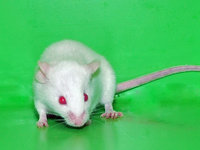Strain Data Sheet
RBRC02393
Strain Information | |
|---|---|
| Image |  |
| BRC No. | RBRC02393 |
| Type | Targeted Mutation |
| Species | Mus musculus |
| Strain name | C.Cg-Aicda<tm1Hon>(N12) |
| Former Common name | BALB/c-Aicda<-/->(N12)mouse |
| H-2 Haplotype | |
| ES Cell line | TT2 [(C57BL/6NCrlj x CBA/JNCrlj)F1] |
| Background strain | BALB/cCrSlc |
| Appearance | albino [A/A b/b c/c] |
| Strain development | Developed by Dr. Masamichi Muramatsu at Kyoto University in 2000. A neomycin resistance cassette was transferred into TT2 ES cells to replace exon 2 and part of exon 3 of the Aicda gene. The Aid deficient mice were backcrossed to BALB/c. |
| Strain description | Aid, Activation-Induced cytidine Deaminase is a molecule which specifically expressed in B lymphocytes after antigen stimulation. AID deficiency causes a complete defect in class switching and shows a hyper-IgM phenotype with enlarged germinal centers containing strongly activated B cells before or after immunization. Accumulation of IgM positive B cells is remarkable in the gut lamina propria. Furthermore, it is suggested that a mutation of the Aid gene is a cause of the hereditary immune deficiency disorder, type-2 hyper-IgM syndrome (HIGM2) in human. As well as class switch recombination, it was also found that somatic hypermutation of an immunoglobulin variable region gene and gene conversion did not occur at all in the Aid deficiency mice. Aid gene is a molecule serving as a central role in antibody gene variety acquisition mechanism of B cell. |
| Colony maintenance | Homozyogte x HomozygoteHomozygous mutant mice are viable and fertile. |
| References | Class switch recombination and hypermutation require activation-induced cytidine deaminase (AID), a potential RNA editing enzyme. Muramatsu M, Kinoshita K, Fagarasan S, Yamada S, Shinkai Y, Honjo T Cell, 102, 553-563 (2000). 11007474Critical roles of activation-induced cytidine deaminase in the homeostasis of gut flora. Fagarasan S, Muramatsu M, Suzuki K, Nagaoka H, Hiai H, Honjo T Science, 298, 1424-1427 (2002). 12434060 |
Health Report | |
|---|---|
| Examination Date / Room / Rack | 2023/11/27Room:4-BRack:ASentinel mouse program 2023/08/28Room:4-BRack:ASentinel mouse program |
Gene | |||||||
|---|---|---|---|---|---|---|---|
| Gene Symbol | Gene Name | Chr. | Allele Symbol | Allele Name | Common Names | Promoter | Diseases Related to This Gene |
| Aicda MGI:1342279 | activation-induced cytidine deaminase | 6 | Aicda<tm1Hon> MGI:2156156 | targeted mutation 1, Tasuku Honjo | |||
| loxP | phage P1 loxP | 6 | loxP | ||||
| loxP | phage P1 loxP | 6 | loxP | ||||
| neo | neomycin resistance gene (E. coli) | 6 | mouse phosphoglycerate kinase promoter (PGK promoter) | ||||
Phenotype | |
|---|---|
| Phenotype annotation from literatures by Mammalian phenotype ontology | more 8 phenotypes |
| Detailed phenotype data | |
Ordering Information | |
|---|---|
| Donor DNA | Phage P1 loxP sites, mouse phosphoglycerate kinase promoter (PGK promoter), E. coli neo, mouse Activation-induced cytidine deaminase (AID) genomic DNA [Update June, 4, 2015] |
| Research application | Cre/loxP system Immunology and Inflammation Research |
| Specific Term and Conditions | 1) The RECIPIENT shall use the BIOLOGICAL RESOURCE only for academic research for the purpose of publishing the research results. 2) In publishing the research results obtained by use of the BIOLOGICAL RESOURCE, an acknowledgment to the DEPOSITOR and a citation of the following literature(s) designated by the DEPOSITOR are requested. Science, 298, 1424-1427 (2002). 3) RECIPIENT shall notify the PROVIDER upon filing a patent application claiming modification of the BIOLOGICAL RESOURCE or method(s) of manufacture or use(s) of the BIOLOGICAL RESOURCE. |
| Depositor | Tasuku Honjo (Kyoto University) |
| Strain Status |  Frozen embryos Frozen embryos Frozen sperm Frozen sperm |
| Strain Availability | Recovered litters from cryopreserved embryos (2 to 4 months) Cryopreserved sperm (within 1 month) Cryopreserved embryos (within 1 month) |
| Additional Info. | Necessary documents for ordering:
Genotyping protocol -PCR- |
BRC mice in Publications |
|---|
| No Data |